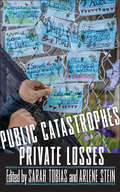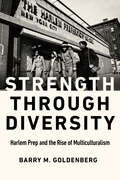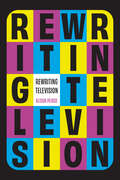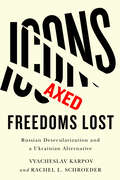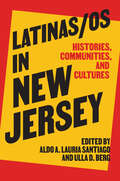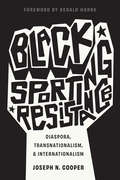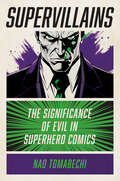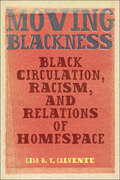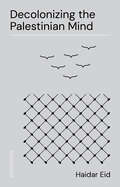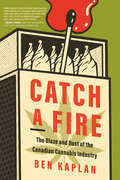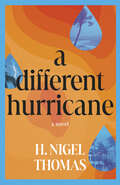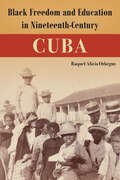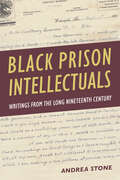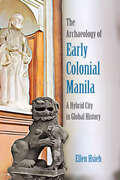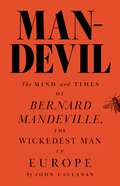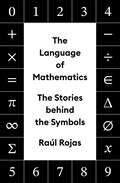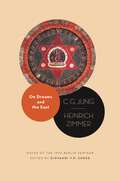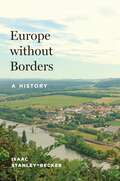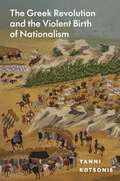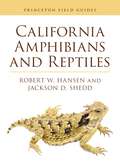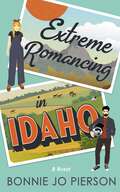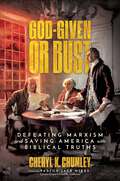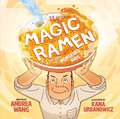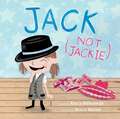- Table View
- List View
Public Catastrophes, Private Losses (The Feminist Bookshelf: Ideas for the 21st Century)
by Naomi Klein Marcia Gallo Christina Sharpe Ellen Malenas Ledoux Kathleen C. Riley Basuli Deb Marisa J. Fuentes Carmen Vázquez Michelle Commander Jennifer Flynn Walker Bela August Walker Smruthi Bala Kannan Stacy S. Klein Leslye Amede ObioraFrom COVID to climate-change-induced wildfires and hurricanes, we live in an era when catastrophes have become the new normal. But even though these events affect us all, some members of society are more vulnerable to harm than others. This essay collection explores how the definition of catastrophe might be expanded to include many forms of large-scale structural violence on communities, species, and ecosystems. Using feminist methodologies, the contributors to Public Catastrophes, Private Losses trace the connections between seemingly unrelated forms of violence such as structural racism, environmental degradation, and public health crises. In contrast to a news media that focuses on mass fatalities and immediate consequences, these essays call our attention to how catastrophes can also involve slow violence with long-term effects. The authors also consider how these catastrophes are profoundly shaped by government action or inaction, offering a powerful critique of how government neglect has cost lives and demonstrating how vulnerable populations can be better protected. The essays in this collection examine how public catastrophes imprint themselves on lives, as individuals and communities narrate, process, and grapple with legacies of loss. The book is thus a feminist intervention that challenges the binary between public and private, personal and political.
Strength through Diversity: Harlem Prep and the Rise of Multiculturalism
by Barry M. GoldenbergFor nearly seven years, from 1967 to 1974, many hundreds of bright, college-going youth—most of whom had previously been labeled as high school “dropouts”—would proudly celebrate their graduation from Harlem Prep, a small educational experiment that grew to become a nationally renowned, cherished community institution in the iconic Black neighborhood of Harlem. Operating in a repurposed supermarket that used blackboards as classroom dividers, the school’s unique multicultural philosophy inspired all who stepped foot inside. This philosophy, exemplified by the school’s motto of “unity through diversity,” shaped the school’s ethos, fostered student achievement, and, most of all, made Harlem Prep distinct from any other educational institution, past or present. In Strength through Diversity, Barry M. Goldenberg shares the history of this one-of-a-kind multicultural institution from its rise to its apex and decline, revealing the collective stories of hope, struggle, and love from administrators, teachers, community members, and students. Using history as a blueprint, Goldenberg illustrates the untapped potential of multicultural education in the ongoing quest for educational equity.
Rewriting Television
by Alison PeirseRewriting Television suggests that it is time for a radical overhaul of television studies. If we don’t want to merely recycle the same old methods, approaches, and tropes for another twenty years, we need to consider major changes in why and how we do our work. This book offers a new model for doing television (or film or media) studies that can be taken up around the world. It synthesizes ideas from production studies, screenwriting studies, and the idea of “writing otherwise” to create a new way of studying television. It presents an entirely original approach to working with practitioner interviews that has never been seen before in film, television, or media studies. It then offers a series of original reflections on form, story, and voice and considers how these reflections could shape future writing in our discipline(s). Ultimately, this is a book of ideas. This book asks “what if?” This book is an opportunity to imagine differently.
Icons Axed, Freedoms Lost: Russian Desecularization and a Ukrainian Alternative
by Vyacheslav Karpov Rachel L. SchroederIn Icons Axed, Freedoms Lost, Vyacheslav Karpov and Rachel L. Schroeder demonstrate how Russia went from persecuting believers to jailing critics of religion and why, in contrast, religious pluralism and tolerance have solidified in Ukraine. Offering a richly documented history of cultural and political struggles that surrounded desecularization—the resurgence of religion’s societal role—from the end of the USSR to the Russo-Ukrainian war, they show Russian critics of desecularization adhered to artistic provocations, from axing icons to “punk-prayers” in cathedrals, and how Orthodox activists, in turn, responded by vandalizing controversial exhibits and calling on the state to crush “the enemies of the Church.” Putin’s solidifying tyranny heard their calls and criminalized insults to religious feelings. Meanwhile, Ukraine adhered to its pluralistic legacies. Its churches refused to engage in Russian-style culture wars, sticking instead to forgiveness and forbearance. Icons Axed, Freedoms Lost offers original theoretical and methodological perspectives on desecularization applicable far beyond the cases of Russia and Ukraine.
Latinas/os in New Jersey: Histories, Communities, and Cultures (CERES: Rutgers Studies in History)
by Lilia Fernandez Johana Londoño Ulla D. Berg Raymond Sanchez Mayers Ana Y. Ramos-Zayas Lyna L. Wiggins Kathleen López Yamil Avivi Benjamin Lapidus Aldo A. Lauria Santiago Olga Jiménez de Wagenheim Elsa Candelario Laura Curran Giovani Burgos Alex F. Trillo Anil Venkatesh Jennifer Ayala Giancarlo Muschi Ismael García Colón William Suárez Gómez Elena Sabogal Melanie Z. Plasencia Daniela ValdesSince the 1890s, New Jersey has attracted hundreds of thousands of Caribbean and Latin American migrants. The state’s rich economic history, high-income suburbs, and strong public sector have all contributed to attracting, retaining, and setting the stage for Latin American and Caribbean immigrants and secondary-step migrants from New York City. Since the 1980s, however, Latinos have developed a more complex presence in the state’s political landscape and institutions. The emergence of Latino-majority towns and cities and coalition politics facilitated the election of Latino mayors, council persons, and many social and community leaders, as well as the election of statewide officers. This collection brings together innovative and empirically grounded scholarship from different disciplines and interdisciplinary fields of study and addresses topics including the demographic history of Latinos in the state, Latino migration from gateway cities to suburban towns, Latino urban enclaves, Latino economic and social mobility, Latino students and education, the New Jersey Dream Act and in-state tuition act organizing, Latinos and criminal justice reform, Latino electoral politics and leadership, and undocumented communities. Contributors: Yamil Avivi; Jennifer Ayala; Ulla D. Berg; Giovani Burgos; Elsa Candelario; Laura Curran; Lilia Fernández; Ismael García Colón; Olga Jiménez de Wagenheim; Benjamin Lapidus; Aldo A. Lauria Santiago; Johana Londoño; Kathleen Lopez; Giancarlo Muschi; Melanie Z. Plasencia; Ana Y. Ramos-Zayas; Elena Sabogal; Raymond Sanchez Mayers; William Suárez Gómez; Alex F. Trillo; Daniela Valdez; Anil Venkatesh; Lyna L. Wiggins
Black Sporting Resistance: Diaspora, Transnationalism, and Internationalism (Critical Issues in Sport and Society)
by Joseph N. CooperIn recent years, there has been increased attention towards activism in sporting spaces. A vast majority of these contributions have focused on intra-nation tensions and impact. Yet, there is a dearth of scholarship that has engaged in a theoretically grounded analysis of how Black sportspersons have exhibited resistance in and through sport across national borders across time, space, and context. In this text, Joseph N. Cooper introduces the Black Sporting Resistance Framework (BSRF) as an analytic lens to examine how resistance actions in and through sport have contributed to the advancement of local and global racial justice efforts. Key concepts such as African (Black) diaspora, transnationalism, internationalism, sporting resistance typology, and sport activism typology are incorporated throughout the book. Black sporting resistance is also analyzed alongside broader social movements such as the Black Liberation Struggle, Black Nationalism, Pan-Africanism, and Black Radicalism. Insights on the ways in which sport can be used to advance social justice in the future are presented.
Supervillains: The Significance of Evil in Superhero Comics
by Nao TomabechiAlongside superheroes, supervillains, too, have become one of today’s most popular and globally recognizable figures. However, it is not merely their popularity that marks their significance. Supervillains are also central to superhero storytelling to the extent that the superhero genre cannot survive without supervillains. Bringing together different approaches and critical perspectives across disciplines, author Nao Tomabechi troubles overly hero-centered works in comics studies to reconsider the modern American myths of the superheroes. Considering the likes of Lex Luthor, the Joker, Catwoman, Harley Quinn, Loki, Venom, and more, Supervillians explores themes such as gender and sexuality, disability, and many forms of Otherness in relation to the notion of evil as it appears in the superhero genre. The book investigates how supervillains uphold and, at times, trouble dominant ideals expressed by the heroism of our superheroes.
Moving Blackness: Black Circulation, Racism, and Relations of Homespace
by Lisa B. CalventeMoving Blackness: Black Circulation, Racism, and Relations of Homespace delves into the intricate connections between communication, culture, power, and racism in relation to blackness. Through a blend of interviews, oral histories, and meticulous archival research, this book sheds light on the multifaceted narratives surrounding Black identity. It explores how these stories circulate, serving as tools of resistance, negotiation, and affirmation of diverse manifestations and representations of blackness. By emphasizing the significance of storytelling as a means through which blackness affirms itself, transcending time and space, the book underscores how communicative embodiments of Black identity enable individuals to persevere within marginalized contexts. Engaging with theories of anti-Black racism, modernity, coloniality, and the Black diaspora, the book frames storytelling and the circulation of narratives as performances deeply rooted in the everyday lives of Black people across the diaspora. Starting with an examination of the racial construction of movement during colonialism and slavery, the book traces how this history shapes contemporary interactions. With its exploration of how Black circulation transforms movement and space, the book introduces a forward-thinking approach to the Black diaspora, anchored in a politics of identification rather than being confined to the past or a specific location. Moving Blackness argues that the desire for homespace, a yearning for belonging that transcends any particular physical space, fuels this envisioned future, rooted in the historical and material conditions of racism and marginalization.
Decolonizing the Palestinian Mind
by Haidar EidDecolonizing the Palestinian Mind is a sharp critique of the Oslo surrender, the Israeli apartheid system established in the name of a two-state solution, and the tokenization of Palestinian struggle and emancipation. It calls for a radical change in consciousness in a new period of unprecedented pressure on Palestinian culture, identity, and futures. Drawing on the works of Edward Said, Ghassan Kanafani, Paolo Freire, Rosa Luxemburg, and Antonio Gramsci, Haidar Eid provides an in-depth look at how alternative political programs and struggles can offer prospects for a just peace.</p
Catch a Fire: The Blaze and Bust of the Canadian Cannabis Industry
by Ben Kaplan“Sharply observed, fiercely researched, starkly revealing, written with wit, verve, and insight, making room for the tragic ironies without ever taking its eyes off the comic ones, Catch a Fire left me shaking with laughter — when I wasn’t shaking my head in dismay.” — MICHAEL CHABONThe untold story of the $131-billion Canadian cannabis blow out.Canopy Growth founder Bruce Linton didn’t invent marijuana, but he figured out how to turn a Canadian start-up selling the stuff into a $22 billion international buzz. Catch a Fire goes behind the scenes of Justin Trudeau’s legalization gambit and the stoned pioneering lawyers who helped make weed gummies more valuable than U.S. Steel. From the dope dealers of the 1960s to the never-before-told bribery accusations during Covid-19, cannabis historian Ben Kaplan speaks with the dealers, stealers, and renegade freaks who made and then lost money with the combined chutzpah of Jeff Bezos, Elon Musk, and Sam Bankman-Fried.This is the definitive history of a massive societal change — and a great boom and bust.
A Different Hurricane
by H. Nigel ThomasTwo gay men with a lifetime of secrets face their insular, homophobic island’s rancour.Growing up in neighbouring villages on the tiny island nation of St Vincent, teenage best friends Gordon and Allen are secret lovers until they are forced apart their community’s traditional expectations and their fear of how others will react. They each complete their university studies abroad, encountering worlds where there is less hostility toward LGBTQ+ people. Tempted to stay, both men ultimately return home, hiding who they are.Their secret lives come at the expense of others, and Gordon’s wife, Maureen, is the first to be irreparably harmed. She has confided her secrets to an accusatory journal, and it is now up to Gordon to keep it from the local media and the unforgiving eyes of the authorities. If the truth is revealed, he and Allan will be the next victims.
Black Freedom and Education in Nineteenth-Century Cuba (Caribbean Crossroads: Race, Identity, and Freedom Struggles)
by Raquel Alicia OtheguyExamining the educational legacy of Afro-Cuban teachers and activists In this book, Raquel Otheguy argues that Afro-descended teachers and activists were central to the development of a national education system in Cuba. Tracing the emergence of a Black Cuban educational tradition whose hallmarks were at the forefront of transatlantic educational currents, Otheguy examines how this movement pushed the island’s public school system to be more accessible to children and adults of all races, genders, and classes. Otheguy describes Afro-Cuban education before public schools were officially desegregated in 1894, from the maestras amigas—Black and mulata women who taught in their homes—to teachers in the schools of mutual-aid societies for people of color. In the ways that Afro-descendants interacted with the Spanish colonial school system and its authorities, and in the separate schools they created, they were resisting the hardening racial boundaries that characterized Cuban life and developing alternative visions of possible societies, nations, and futures. Otheguy demonstrates that Black Cubans pioneered the region’s most progressive innovations in education and influenced the trajectory of public school systems in their nation and the broader Americas. A volume in the series Caribbean Crossroads: Race, Identity, and Freedom Struggles, edited by Lillian Guerra, Devyn Spence Benson, April Mayes, and Solsiree del Moral Publication of this work made possible by a Sustaining the Humanities through the American Rescue Plan grant from the National Endowment for the Humanities
Black Prison Intellectuals: Writings from the Long Nineteenth Century
by Andrea StoneHow early Black prison writing shaped Black intellectual movements In this book, Andrea Stone recovers critical, understudied writings from early archives to call into question the idea that the Black prison intellectual movement began in the twentieth century. In fact, nearly two centuries before Angela Davis and Eldridge Cleaver, Black prisoners were serving as thought leaders and contributing to political movements. By illuminating their pathbreaking voices, Stone shows that prison writing from this era was a foundational part of Black American intellectualism. Grounding her work in a history of the disproportionately high incarceration of Black Americans, Stone traces the arc of Black prison writing from 1795 to 1901. She analyzes gallows literature, court records, newspaper coverage, and parole request letters, arguing that parole requests represent an undervalued, vital literary genre. Most of the writers featured in this book were effectively treated as enemies of the state, leading Stone to a question that continues to resonate in America today: what is the distinction between criminal and enemy, and how are those categories intertwined with Blackness in the United States? Black Prison Intellectuals sheds light on the roots of issues like structural racism and mass incarceration. Looking at an important literary tradition that contributed to the Black American intellectual movement, this book helps readers better understand the present as a moment in the long journey toward a racially just society. Publication of this work made possible by a Sustaining the Humanities through the American Rescue Plan grant from the National Endowment for the Humanities.
The Archaeology of Early Colonial Manila: A Hybrid City in Global History
by Ellen HsiehA view into the diverse culture of the Philippines in the sixteenth and seventeenth centuries Although Manila, capital city of the Philippines, played a critical role in economic and cultural exchanges between the East and the West during the sixteenth and seventeenth centuries, little is known about what life was like for its residents during this time. In this book, Ellen Hsieh uses archaeological, historical, and ethnographic resources to document the ways Manila was transformed by the arrival of Spanish colonists in 1571 and how the city in turn shaped the modern world. Manila was uniquely positioned as a crossroads in the networks of Southeast Asia, East Asia, and Iberia, resulting in a hybridized culture where colonial Spanish, Indigenous Tagalog, and overseas Chinese groups exchanged goods and ideas. In The Archaeology of Early Colonial Manila, Hsieh analyzes material goods such as ceramics from Intramuros (the Spanish walled city) and Parian (the Chinese quarter) and illustrations from the Boxer Codex—a Spanish manuscript featuring images of people in the Philippines and surrounding areas—to illuminate the diversity of Manila society and to unravel the intricate power dynamics among these ethnic groups. Bridging the gap in research between pre-Spanish and late colonial periods and amplifying the voices of non-elite, diasporic, and colonized communities often overlooked in historical documents, Hsieh provides an important focus on Manila’s contributions to world history during a period of intense globalization.
Man-Devil: The Mind and Times of Bernard Mandeville, the Wickedest Man in Europe
by John J. CallananA lively and provocative account of Bernard Mandeville and the work that scandalized and appalled his contemporaries—and made him one of the most influential thinkers of the eighteenth centuryIn 1714, doctor, philosopher and writer Bernard Mandeville published The Fable of the Bees, a humorous tale in which a prosperous hive full of greedy and licentious bees trade their vices for virtues and immediately fall into economic and societal collapse. Outrage among the reading public followed; philosophers took up their pens to refute what they saw as the fable&’s central assertion. How could it be that an immoral community thrived but the introduction of morality caused it to crash and burn? In Man-Devil, John Callanan examines Mandeville and his famous fable, showing how its contentious claim—that vice was essential to the economic flourishing of any society—formed part of Mandeville&’s overall theory of human nature. Mandeville, Callanan argues, was perfectly suited to analyze and satirize the emerging phenomenon of modern society—and reveal the gap between its self-image and its reality.Callanan shows that Mandeville&’s thinking was informed by his medical training and his innovative approach to the treatment of illness with both physiological and psychological components. Through incisive and controversial analyses of sexual mores, gender inequality, economic structures, and political ideology, Mandeville sought to provide a naturalistic account of human behavior—one that put humans in close continuity with animals. Aware that his fellow human beings might find this offensive, he cloaked his theories in fables, poems, anecdotes, and humorous stories. Mandeville mastered irony precisely for the purpose of making us aware of uncomfortable aspects of our deepest natures—aspects that we still struggle to acknowledge today.
The Language of Mathematics: The Stories behind the Symbols
by Raúl RojasA marvelous compendium of mathematical symbols and their fascinating historiesGalileo famously wrote that the book of nature is written in mathematical language. The Language of Mathematics is a wide-ranging and beautifully illustrated collection of short, colorful histories of the most commonly used symbols in mathematics, providing readers with an engaging introduction to the origins, evolution, and conceptual meaning of each one.In dozens of lively and informative entries, Raúl Rojas shows how today&’s mathematics stands on the shoulders of giants, mathematicians from around the world who developed mathematical notation through centuries of collective effort. He tells the stories of such figures as al-Khwārizmī, René Descartes, Joseph-Louis Lagrange, Carl Friedrich Gauss, Augustin-Louis Cauchy, Karl Weierstrass, Sofia Kovalevskaya, David Hilbert, and Kenneth Iverson. Topics range from numbers and variables to sets and functions, constants, and combinatorics. Rojas describes the mathematical problems associated with different symbols and reveals how mathematical notation has sometimes been an accidental process. The entries are self-contained and can be read in any order, each one examining one or two symbols, their history, and the variants they may have had over time.An essential companion for math enthusiasts, The Language of Mathematics shows how mathematics is a living and evolving entity, forever searching for the best symbolism to express relationships between abstract concepts and to convey meaning.
Negotiation: The Game Has Changed
by Max H. BazermanFrom the world&’s leading expert on negotiation, an essential guide to negotiating in any situation—whether over Zoom, across political and cultural divides, or during a supply chain crisisThe world has changed dramatically in just the past few years—and so has the game of negotiation. COVID-19, Zoom, political polarization, the online economy, increasing economic globalization, and greater workplace diversity—all have transformed the who, what, where, and how of negotiation. Today, traditional negotiating tactics, while still effective, need to be tailored to vastly different situations and circumstances. In Negotiation: The Game Has Changed, legendary Harvard Business School professor Max Bazerman, a pioneer in the field of negotiation, shows you how to negotiate successfully today by adapting proven negotiation principles and strategies to the challenging new contexts you face—from negotiating across cultural and political differences to trying to reach an agreement over Zoom or during a supply chain crisis.Negotiation offers a groundbreaking new way of thinking about the importance of the unique context of any negotiation—and when and how it should influence how you negotiate. At the same time, the book provides a concise and expert overview of essential negotiating techniques for anyone new to the subject or who wants a refresher. The result is a must-read—a powerful toolkit for successfully negotiating in a world where the game of negotiation has changed.
On Dreams and the East: Notes of the 1933 Berlin Seminar (Philemon Foundation Series)
by C. G. Jung Heinrich ZimmerJung&’s landmark seminar on the symbolism of yoga and its applications to dream analysisIn the summer of 1933, C. G. Jung conducted a seminar in Berlin attended by a large audience of some 150 people, including several Jewish Jungians who would soon leave Germany. Hitler had begun consolidating his position as dictator and these students were distressed at Jung&’s recent decision to accept the presidency of a German professional psychotherapy society that was rapidly becoming Nazified and purged of Jews. On Dreams and the East makes these seminar sessions widely available for the first time, offering tantalizing insights into Jung&’s evolving understanding of yoga and the realization of the self.The seminar commences with a presentation on the psychology of yoga by noted Indologist and linguist Heinrich Zimmer, whose collaboration in these talks reflects Jung&’s growing engagement with the Hindu tradition, particularly Tantric yoga. Jung analyzes a series of dreams of a middle-aged male patient, focusing on mandalas and the centering process. He reflects on related motifs in alchemical symbolism, Navaho healing drawings, Mithraism, baptism symbolism, the foundation of Rome, ecclesiastic dances, and labyrinths, drawing connections with the symbolism of yoga and Tantra.Featuring a richly documented introduction by Giovanni Sorge, On Dreams and the East opens a window on Jung&’s deepening exploration of Eastern thought and the comparative study of the individuation process at a critical juncture in his life and work.
Europe without Borders: A History
by Isaac Stanley-BeckerThe contested creation of free movement—for people and goods—in the Schengen area of EuropeEurope is a place of free movement among nations—or is it? The Schengen area, established in 1985 and today encompassing twenty-nine European countries, allows people, goods, and capital to cross borders without restraint. Schengen transformed European life, advancing both a democratic project of transnational citizenship and a neoliberal project of international free trade. But the right of free movement always excluded non-Europeans, especially migrants of color from former colonies of the Schengen states. In Europe without Borders, Isaac Stanley-Becker explores the contested creation of free movement in Schengen, from treatymaking at European summits and disputes in international courts to the street protests of undocumented immigrants who claimed free movement as a human right.Schengen laid the groundwork for the making of a single market and the founding of the European Union. Yet its emergence is one of the great untold stories of modern European history, one hidden in archives long embargoed. Stanley-Becker is among the first to have access to records of the treatymaking—such as letters between France&’s François Mitterrand and West Germany&’s Helmut Kohl—and Europe without Borders offers a pathbreaking account of Schengen&’s creation. Stanley-Becker argues that Schengen gave a humanist cast to a market paradigm; but even in pairing the border crossing of human beings with the principles of free-market exchange, this vision of free movement was hedged by alarm about foreign migrants. Meanwhile, these migrants—the sans-papiers—saw in the promise of a borderless Europe only a neocolonial enterprise.
The Greek Revolution and the Violent Birth of Nationalism
by Yanni KotsonisA sweeping global history of the birth of modern GreeceIn 1821, a diverse territory in the southern Balkans on the fringe of the Ottoman Empire was thrust into a decade of astounding mass violence. The Greek Revolution and the Violent Birth of Nationalism traces how something new emerged from an imperial mosaic of myriad languages, religions, cultures, and localisms—the world&’s first ethnic nation-state, one that was born from the destruction and the creation of whole peoples, and which set the stage for the modern age of nationalism that was to come.Yanni Kotsonis exposes the everyday chaos and brutality in the Balkan peninsula as the Ottoman regime unraveled. He follows the future Greeks on the seaways to Odesa, Alexandria, Livorno, and the Caribbean, and recovers the stories of peasants, merchants, warriors, aristocrats, and intellectuals who navigated the great empires that crisscrossed the region. Kotsonis recounts the experiences of the villagers and sailors who joined the armed battalions of the Napoleonic Wars and learned a new kind of warfare and a new practice of mass mobilization, lessons that served them well during the revolutionary decade. He describes how, as the bloody 1820s came to a close, the region&’s Muslims were no more and Greece was an Orthodox Christian nation united by a shared language and a claim to an ancient past.This panoramic book shows how the Greek Revolution was a demographic upheaval more consequential than the overthrow of a ruler. Drawing on Ottoman sources together with archival evidence from Greece, Britain, France, Russia, and Switzerland, the book reframes the birth of modern Greece within the imperial history of the global nineteenth century.
California Amphibians and Reptiles (Princeton Field Guides)
by Robert Hansen Jackson D. SheddA spectacularly illustrated field guide to the amphibians and reptiles of CaliforniaCalifornia is home to more than 200 species of reptiles and amphibians that can be found in an extraordinary array of habitats, from coastal temperate rainforests with giant redwoods to southeastern deserts offering dazzling wildflower displays each spring. California Amphibians and Reptiles covers every species and subspecies in this biodiverse region of the United States, with outstanding color photography and in-depth species accounts that draw on the latest findings on taxonomy and distribution. Setting a new standard for regional field guides, this state-of-the-art guide will serve as the definitive reference for California&’s amphibian and reptile fauna for many years to come.Covers all 209 species of amphibians and reptiles found in CaliforniaFeatures hundreds of stunning photos that illustrate geographic and within-species variation as well as differences among males, females, and youngIncludes first-ever color images and species accounts for newly discovered speciesShows every species and subspecies in full color on a white backgroundDepicts all amphibian larvae in breathtaking colorDetailed species accounts describe key identification features, similar species, habitat, range and elevation, activity and behavior, diet, reproduction, and conservationProvides updated status of all threatened, endangered, nonnative, and special concern speciesAccurate range maps reflect contemporary and, where applicable, historical distributions in light of significant habitat loss across the stateAn invaluable resource for amateur naturalists, resource managers, and professional herpetologists
Extreme Romancing in Idaho (Clear Springs Romance #2)
by Bonnie Jo PiersonA heartfelt romance set in rural Idaho, perfect for fans of Robyn Carr and Jojo Moyes, exploring love&’s triumph over material desires.Angie Johnson wants nothing more than to keep her parents' struggling Idaho farm running, maintain her career as a NICU nurse, and find a man to marry before her father passes away from cancer. Unfortunately, even if she had time to meet someone, the online dating world is full of dead ends. That is, until she meets Daniel Smoot, a man ready to settle down on her timeline. Unfortunately, in order to reel him in, Angie may have told him a little white lie: that she, who is afraid of heights, is very into extreme sports. Remington James the Third has his own set of problems, and finding a woman is not one. He's in town to convince Angie's parents to sell their land to his family's development company. In order to get on their good side, he takes a job at the farm and volunteers to help Angie snag Smoot by training her in extreme sports and the intricate art of seduction. What he doesn't plan on is falling for the woman whose life he's been ordered to uproot. A wholesome romance about choosing love over your bank account, Extreme Romancing in Idaho will steal your heart.
God-Given or Bust: Defeating Marxism and Saving America with Biblical Truths
by Cheryl K. ChumleyIn America, either rights come from God—or they don&’t. This is the ultimate war, and God-Given or Bust tells how patriots can win.American exceptionalism is rooted in the idea that individual rights come from God and government is only in place to preserve and protect those rights. But America&’s losing sight of that concept. America&’s turning into a country where the government grants rights and privileges to only those the government deems worthy—and takes them from those it deems unworthy. This is not how the Founding Fathers envisioned the nation; this is not how the concept of inalienable rights coming from a Creator works. Rather, this is how Marxism, communism, and collectivism spread. If we want a nation that&’s free for generations to come, then we must reclaim the notion of God-given and ditch the idea of government-granted. The only way to do that is for Americans of faith to rise up and inject biblical values and godly principles into government, culture, and society, and put God once again at the center. It&’s time to demand the God-given—or the great American experiment will come to an end.
Magic Ramen: The Story of Momofuku Ando
by Andrea WangWorld War II was over, but in Japan, lines for a simple bowl of ramen noodles wound down the sidewalk. What Momofuku Ando did next would change food forever. Andrea Wang, author of Watercress (a Newberry honor book and winner of the Caldecott Medal), tells the true story behind the creation of one of the world's most popular foods."An inspiring story of persistence and an ideal purchase for any collection." School Library Journal, STARRED review2021 Nutmeg Book Awards NomineeWinner of the 2020 Sakura AwardRead Across America Book of the Month, May 2021Center for Multicultural Children's Literature Best Book of 2019 ListSmithsonian Magazine '10 Best Children's Books of 2019′ ListEvery day, Momofuku Ando would retire to his lab--a little shed in his backyard. For years, he'd dreamed about making a new kind of ramen noodle soup that was quick, convenient, and tasty for the hungry people he'd seen in line for a bowl on the black market following World War II. Peace follows from a full stomach, he believed.Day after day, Ando experimented. Night after night, he failed. But Ando kept experimenting.With persistence, creativity, and a little inspiration, Ando succeeded. This is the true story behind one of the world's most popular foods.
Jack (Not Jackie)
by Erica SilvermanIn this heartwarming picture book, a big sister realizes that her little sister, Jackie, doesn't like dresses or fairies-she likes ties and bugs! Will she and her family be able to accept that Jackie identifies more as "Jack"?Susan thinks her little sister Jackie has the best giggle! She can't wait for Jackie to get older so they can do all sorts of things like play forest fairies and be explorers together. But as Jackie grows, she doesn't want to play those games. She wants to play with mud and be a super bug! Jackie also doesn't like dresses or her long hair, and she would rather be called Jack.Readers will love this sweet story about change and acceptance. This book is published in partnership with GLAAD to accelerate LGBTQ inclusivity and acceptance.
